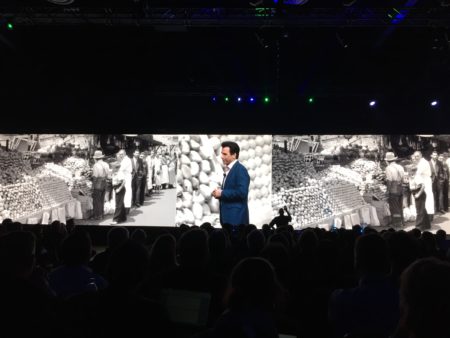January is the month where industry leaders and analysts tend to make predictions for the new year. What will the big trends be in technology in 2019 and what impact will they have on CAD-CAM industries from AEC to manufacturing?
Below we have some predictions from Tech Soft 3D VP of Development, Dave Opsahl and Autodesk CEO Andrew Anagnost.
Trend One—Acquisitions and Venture Capital in CAD Industries
There is a massive amount of venture capital out there. US-based start-ups raised nearly $100 billion in 2018. And much of that money is aimed at expansion stage or later, as compared to the previous past few years.
Dave Opsahl, VP of Corporate Development at Tech Soft 3D believes the pace of acquisitions and industry consolidation will continue. However, “with the threat of economic slowdown, it isn’t as safe a pick as one might think.” As noted earlier, Opsahl says that “the pace of acquisitions in 2018 dwarfed that of recent years and shows no sign of slowing.” With the private equity market flush with record amounts of cash, corporate buyers will be looking to put that money to work.

01 – Autodesk CEO Andrew Anagnost, during his keynote at AU 2018, talks about how automation in food farming didn’t destroy all food industry jobs but actually led to all the new types of food industry jobs we have today.
Autodesk CEO Andrew Anagnost would agree. He notes. “In the past year, we saw a significant increase in the amount of money invested in construction—$1.05 billion invested in construction tech startups in H1 of 2018, with 119 funding deals involving construction tech startups.” This is up from 104 and 97 in 2017 and 2016, respectively.
Autodesk, of course, is right on top of this trend. The company invested in seven construction startups since 2017 and acquired three. These included notables like Assemble Systems and PlanGrid, and BuildingConnected.
Trend Two—AI / Machine Learning in Construction
Artificial intelligence (AI) may still seem like far-off sci-fi technology but in reality, machine learning (ML) and deep learning have been exploding behind the scenes in every industry as well as in the lab and at universities.
In the past year, we saw a significant increase in the amount of money invested in construction—$1.05 billion invested in construction tech startups in H1 of 2018, with 119 funding deals involving construction tech startups.
“Autodesk anticipates the increased exploration and deployment of artificial intelligence (AI)-powered algorithms in construction,” says Anagnost, “which already demonstrate significant benefits to the industry.” Throughout 2019 Anagnost sees AI/ML emerging on the job site more frequently, Anagnost adding that “more firms will realize its benefits to the construction workflow, saving companies time, money and, most importantly, increasing workers’ safety.”
Autodesk has made investments in machine learning in construction very early, specifically in its BIM 360 Project IQ and Smartvid.io acquisition. With the former, 40 contractors have reported improved quality and reduced risk to personnel, specifically reducing risk of the ‘fatal four.’
Trend Three—Licensed Revenue for AEC/BIM/Process Industries Exceed Discrete Manufacturing Industry
Tech Soft 3D’s Dave Opsahl says manufacturing’s days of being the revenue king for solution developers is waning. Over the last several years advances in AEC/BIM/Process industries have driven massive workflow changes. “There has been much press given to the benefits of BIM as what amounts to a ‘digital twin’ of a building or plant for an owner-operator,” he says, adding, “and substantial amounts of new regulations demanding BIM compliance, mostly in Western Europe.”
Trend Four—Industrialized Construction Emerges From Edge to Mainstream
The fourth trend is one of the more interesting ones. Autodesk CEO Andrew Anagnost believes that that 2018 was the year that construction firms turned to industrialized construction practices to meet the ever-increasing demand for commercial and residential buildings. This comment actually rings true for me based on my practice life in 2018. It was actually in 2017 that I encountered the first project in my career where a GC turned to industrialized factory-based framing to speed the project schedule along on a $7 million custom residence. (image 03)

03 – An example of industrialized construction at a small scale at a wood framing fabrication factory line on Cape Cod in Massachusetts. The author’s own project was framed unconventionally via a semi-automated line with computer-controlled equipment doing much of the cutting and nailing.
“In 2018 we saw many construction firms begin to turn to industrialized construction practices,” says Anagnost. “We are seeing more and more firms adopt methods like prefabricated and modular construction, resulting in building components being created quickly and accurately, with less waste.” In the case of my experience, the benefit of framing a wood framed single-family home of considerable size and complexity in a factory (all the walls were built there, just walls) was that as soon as the first floor was decked in plywood, the next day all the first floor walls arrived and were erected in a day. This process saved two to three weeks in the schedule; this process also led to superior accuracy and quality.
Autodesk expects to see wider adoption of industrialized construction. And the company is investing wisely in this sector of the AEC industry.
Trend Five—Simulation Process and Data Management: The Next Big Thing
“Every so often our industry hits an inflection point, where the technology now available makes it possible to re-think the way we do things,” says Opsahl, of Tech Soft 3D. Noting that the industry passed such inflection points in the past with technologies like solid modeling, additive manufacturing, IoT, and generative design, SPDM (simulation process and data management) will likely make the same big impact.
The goal is to democratize the use of analysis and simulation data, which enable process improvements across multiple disciplines.
Opsahl says that SPDM is turning “the way we think of the role of CAE (computer-aided engineering) and simulation on its head.” “The goal is to democratize the use of analysis and simulation data,” he adds, “which enable process improvements across multiple disciplines.”
Opsahl says that users in 2019 will see a “host of new offerings coming in the SPDM space” and that sounds a bit exciting to us. Architosh was early to noting the role and importance of democratizing analysis applications when we discussed what we called “up-fronting” the analysis part of the design process. This is especially interesting in architecture where energy analysis traditionally has happened at the back-end of the design process. This is why we awarded tools like Sefaira’s SketchUp plugin and Autodesk FormIt BEST of SHOW award nods at AIA National conferences in the past.
Recently we have noted some interesting SaaS-based simulation offerings. One of those is from SimScale which can handle an ASHRAE standard 55 thermal comfort assessment.
Architosh Commentary
What is happening with AI (artificial intelligence) and ML (machine learning) is a key interdependency has now emerged on the scene—big data. The techno-economic historian and theorist Carlota Perez discusses how any technology revolution doesn’t just operate in a vacuum but relies on synergistic connections. She explains: “Each technological revolution results from the synergistic interdependence of a group of industries with one or more infrastructure networks.” We discuss this in detail “Part 1: From Hype-Cycle to Carlota Perez’s Technological Revolutions” here.
MORE: Perspectives on BEST of SHOW 2018: Perez’s Model of Technological Revolutions—BIM, CDEs, and VR
Autodesk CEO Andrew Anagnost’s 2019 predictions about AI and ML reflect a larger group of interdependent industries. The big linkage is between the world of manufacturing (making) and the world of building (AEC). Perez says that disruptive innovations when accompanying “facilitating infrastructure” ultimately change organizational models about how things get done before they coalesce into a new “common sense.” That facilitating infrastructure is AI and ML.
In Perez’s Techno-Economic Paradigm (TEP) model, each technological revolution consists of one to two key raw materials or energies and a pivotal infrastructure. In the 4th revolution, the era of Mass Production, the interstate highway system was a key part of that infrastructure. (see here for a great chart on Perez’s TEP model). Just as trucking and the interstate highway system accelerated the movement of mass manufacturing goods to consumers in the US and other western societies from the 1950’s onward, the new AI and ML tools are rapidly accelerating another type of production—decision-support laden information (or data).
A key aspect of Perez’s TEP model is that key materials in each techno-economic paradigm shift (which she sometimes calls a “surge”) are relatively cheap. The data behind “big data” that is powering the surge in AI and ML has become cheap in the era of mobile and cloud. People today give away their data every day for free on social media platforms and by using their apps on mobile devices or by swiping their saliva in the fun pursuit of finding out if they are German or Irish.
Editor’s Note
We have corrected this article since the original publication to note that Autodesk invested in seven construction technology companies (not acquired) and acquired three since 2017. (16 Jan 19)




Reader Comments
A pleasure to see my theory well understood (here and in other blogs by Anthony Frausto-Robledo) as a macro-context to the way specific technologies evolve.
Regards, Carlota Perez
A pleasure to see my theory well understood (here and in other blogs by Anthony Frausto-Robledo) as a macro-context to the way specific technologies evolve.
Regards, Carlota Perez
Dear Carlota,
It is an honor to receive this kind comment and for you to have taken the time to leave a brief note. In the referenced article in this post are some intensive discussion and charts about your TEP theory. It has been invaluable in our evolving understanding of technology trajectories and technology dynamics within the AEC and manufacturing industries. Thanks again.
Anthony Frausto-Robledo, Editor-in-Chief.
A pleasure to see my theory well understood (here and in other blogs by Anthony Frausto-Robledo) as a macro-context to the way specific technologies evolve.
Regards, Carlota Perez
Dear Carlota,
It is an honor to receive this kind comment and for you to have taken the time to leave a brief note. In the referenced article in this post are some intensive discussion and charts about your TEP theory. It has been invaluable in our evolving understanding of technology trajectories and technology dynamics within the AEC and manufacturing industries. Thanks again.
Anthony Frausto-Robledo, Editor-in-Chief.
Comments are closed.